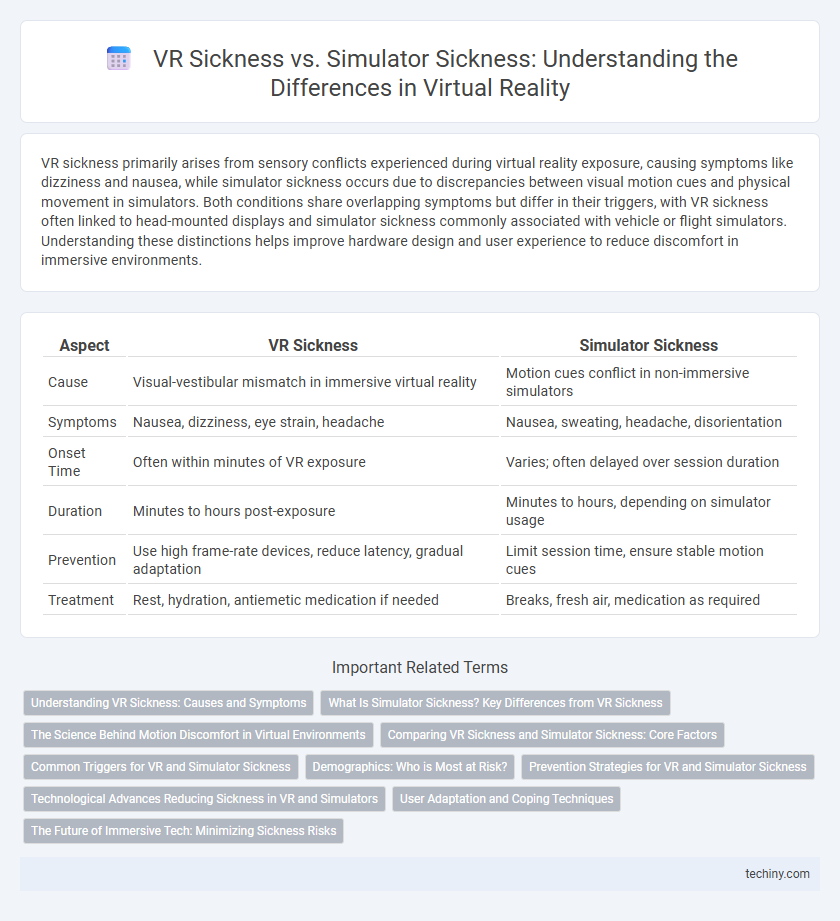VR sickness primarily arises from sensory conflicts experienced during virtual reality exposure, causing symptoms like dizziness and nausea, while simulator sickness occurs due to discrepancies between visual motion cues and physical movement in simulators. Both conditions share overlapping symptoms but differ in their triggers, with VR sickness often linked to head-mounted displays and simulator sickness commonly associated with vehicle or flight simulators. Understanding these distinctions helps improve hardware design and user experience to reduce discomfort in immersive environments.
Table of Comparison
| Aspect | VR Sickness | Simulator Sickness |
|---|---|---|
| Cause | Visual-vestibular mismatch in immersive virtual reality | Motion cues conflict in non-immersive simulators |
| Symptoms | Nausea, dizziness, eye strain, headache | Nausea, sweating, headache, disorientation |
| Onset Time | Often within minutes of VR exposure | Varies; often delayed over session duration |
| Duration | Minutes to hours post-exposure | Minutes to hours, depending on simulator usage |
| Prevention | Use high frame-rate devices, reduce latency, gradual adaptation | Limit session time, ensure stable motion cues |
| Treatment | Rest, hydration, antiemetic medication if needed | Breaks, fresh air, medication as required |
Understanding VR Sickness: Causes and Symptoms
VR sickness primarily arises from sensory conflicts between visual input and vestibular signals, causing dizziness, nausea, and disorientation in users of virtual reality systems. Simulator sickness shares similar symptoms but often results from discrepancies between expected and actual motion, making it common in flight and driving simulators. Understanding these causes helps in designing hardware and software to minimize discomfort during immersive VR experiences.
What Is Simulator Sickness? Key Differences from VR Sickness
Simulator sickness is a condition caused by exposure to motion simulators, characterized by symptoms like nausea, dizziness, and headaches due to sensory conflict between visual inputs and physical movement. Unlike VR sickness, which arises from discrepancies between virtual environments and user motion in head-mounted displays, simulator sickness often occurs in fixed-seat setups such as flight or driving simulators. Key differences include the source of sensory mismatch--simulator sickness stems from vestibular and proprioceptive conflicts in physical simulators, whereas VR sickness primarily involves visual-vestibular discord in immersive virtual reality systems.
The Science Behind Motion Discomfort in Virtual Environments
Motion discomfort in virtual environments stems from sensory conflict between the vestibular system and visual inputs, where the brain receives mismatched signals about body movement. VR sickness primarily results from latency, frame rate issues, and unrealistic motion cues in headset displays, leading to nausea, dizziness, and disorientation. Simulator sickness shares similar symptoms but often arises from fixed-seat simulators with inconsistent motion cues, highlighting the role of sensory integration and adaptation in motion-induced sickness.
Comparing VR Sickness and Simulator Sickness: Core Factors
VR sickness and simulator sickness both result from sensory conflict but differ in their core factors and environments. VR sickness primarily arises from a mismatch between visual motion cues and vestibular signals in immersive virtual environments, often exacerbated by latency, frame rate issues, and field of view limitations. Simulator sickness, common in flight or driving simulators, is caused by prolonged exposure to fixed visual input without corresponding physical movement, emphasizing factors like motion cue discrepancies and simulator design quality.
Common Triggers for VR and Simulator Sickness
Common triggers for VR sickness include latency issues, low frame rates, and mismatched sensory inputs between visual and vestibular systems. Simulator sickness often arises from prolonged exposure to motion cues that conflict with the body's sense of balance, such as repetitive or unnatural movement patterns in flight simulators. Both conditions are exacerbated by field of view limitations, poor graphical fidelity, and improper hardware calibration.
Demographics: Who is Most at Risk?
VR sickness and simulator sickness primarily affect individuals differently based on age, gender, and prior experience with virtual environments. Women and younger users, especially those under 30, are statistically more susceptible to VR sickness due to heightened sensory sensitivity and vestibular system differences. People new to virtual reality or those prone to motion sickness in general are at an increased risk of experiencing symptoms such as nausea, dizziness, and disorientation.
Prevention Strategies for VR and Simulator Sickness
Effective prevention strategies for VR and simulator sickness include managing exposure time by taking frequent breaks and gradually increasing session duration to allow user adaptation. Optimizing hardware settings such as refresh rate, latency reduction, and field of view adjustment minimizes sensory conflicts that cause discomfort. Implementing ergonomic design in VR headsets and simulator cockpits enhances user comfort and reduces the likelihood of motion sickness symptoms.
Technological Advances Reducing Sickness in VR and Simulators
Technological advances in VR and simulators are significantly reducing VR sickness and simulator sickness through improved motion tracking, higher frame rates, and enhanced display resolutions. Eye-tracking technology and adaptive frame rate systems minimize sensory conflicts that typically cause nausea and disorientation. These innovations create smoother, more immersive experiences that align visual cues with user movements, effectively mitigating the symptoms associated with both VR and simulator environments.
User Adaptation and Coping Techniques
User adaptation to VR sickness involves gradual exposure therapy and controlled session durations to minimize symptoms such as dizziness, nausea, and disorientation commonly triggered by sensory mismatches. Simulator sickness, often experienced in flight simulators, shares similar symptoms but can be mitigated through hardware improvements like higher frame rates and reduced latency, as well as software techniques including predictive motion cues and optimized field of view. Coping techniques for both VR and simulator sickness emphasize personalized calibrations, biofeedback mechanisms, and ergonomic designs to enhance user comfort and prolong engagement.
The Future of Immersive Tech: Minimizing Sickness Risks
VR sickness, caused by sensory conflicts in virtual environments, differs from simulator sickness, which typically stems from motion discrepancies in physical simulators. Advances in immersive technology aim to reduce these symptoms through improved motion tracking, higher frame rates, and adaptive user interfaces. Future innovations in VR hardware and software focus on enhancing user comfort and minimizing nausea, enabling longer and more realistic virtual experiences.
VR sickness vs Simulator sickness Infographic

 techiny.com
techiny.com